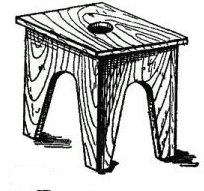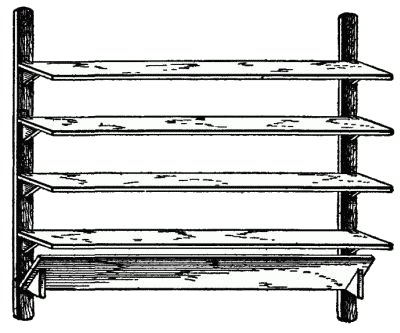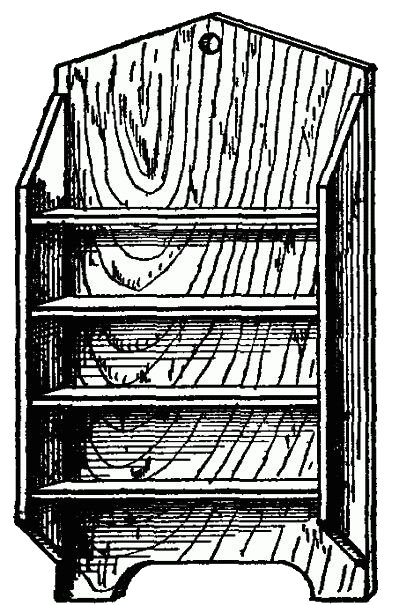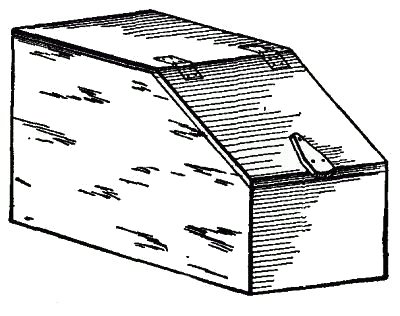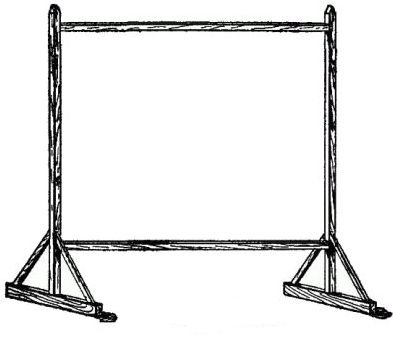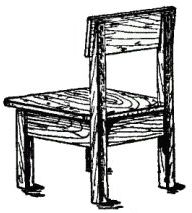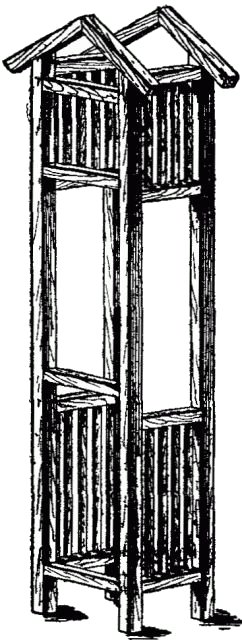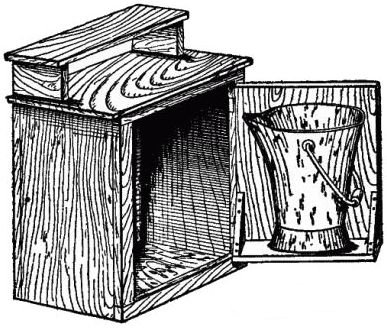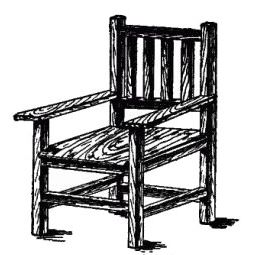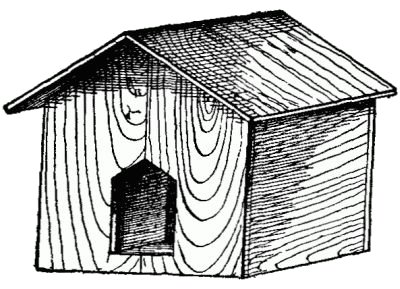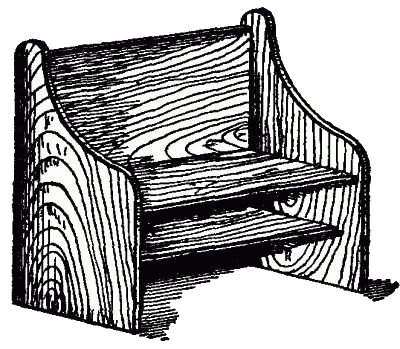
Reprint from THE "HOW-TO-DO-IT" BOOKSCARPENTRY FOR BOYS
|
I - II - III - IV - V - VI - VII - VIII - IX - X - XI - XII - XIII - XIV - XV - XVI - XVII - XVIII - XIX - XX - XXI
CHAPTER XVII
USEFUL ARTICLES TO MAKEAs stated in the Introductory, the purpose of this book is to show how to do the things, and not to draw a picture in order to write a description of it. Merely in the line of suggestion, we give in this chapter views and brief descriptions of useful household articles, all of which may be made by the boy who has carefully studied the preceding pages. This figure shows a common bench wholly made of material 1 inch thick, the top being 12 inches wide and 4 feet long. The legs are 14 inches high and 13 inches wide; and the side supporting rails are 3 inches wide. These proportions may, of course, be varied. You will note that the sides of the top or seat have an overhang of ½ inch on each margin. This is a common, square-top stool, the seat being 12" × 12", and the legs 14 inches high. Two of the pieces forming the legs are 10 inches wide and the other two 8 inches wide, so that when the wide pieces are nailed to the edges of the narrow pieces the leg body will be 10" × 10" and thus give the seat an overhang of 1 inch around the margins. A most useful article is shown in Fig. 249. It is a blacking-box with a lid, a folding shoe rest and three compartments. The detached figure shows a vertical cross-section of the body of the box, and illustrates how the shoe rest is hinged to the sides of the box. The box itself is 14" × 16" in dimensions; the sides are 6 inches wide and the legs 5 inches in height. In order to give strength to the legs, the bottom has its corners cut out, to permit the upper ends of the legs to rest in the recesses thus formed. This is a convenient form of easel, made of four uprights. The main front uprights are of strips 5/8" × 1¼", and the rear uprights are of ½" × 1" material. A thin broomstick will serve as the pivot bar for the upper end. The rest is made of two strips, each ½" × 1", nailed together to form an L, and nails or wooden pins will serve to hold the rest in any desired position. The front uprights should be at least 5 feet long. A simple hanging book-rack is illustrated in Fig. 251. The two vertical strips are each 4 inches wide, 1 inch thick and 4 feet long. Four shelves are provided, each ¾ inch thick, 9 inches wide and 4 feet long. Each shelf is secured to the uprights by hinges on the upper side, so as to permit it to be swung upwardly, or folded; and below each hinge is a triangular block or bracket, fixed to the shelf, to support it in a horizontal position. A sad-iron holder, or bookcase, shown in Fig. 252, is another simple form of structure. It may be sufficiently large to serve as a standing case by having the uprights at the ends serve as legs, or the uprights may have holes at their upper ends, by means of which it can be suspended on a wall. As shown, it is 30 inches long from bottom to top, and 20 inches wide. The shelves are 8 inches wide. All the material is, preferably, ¾-inch stock. Fig. 253 shows a wood-box, or it may readily be adapted for coal. For wood it should be 2 feet long, 1 foot 8 inches wide and 1 foot 10 inches high. It will, of course, be made of such dimensions as to suit the wood to be stored in it, and both the flat-top as well as the sloping portion of the top should be hinged, so that the entire top can be opened for filling purposes. A pair of parallel bars is shown in Fig. 254. The dimensions of this will vary, and be dependent on the size of the boy intending to use it; but a size best adapted is to make the posts 3 feet high, and the distance between the bars 16 inches. This gives ample room for the exercises required. The length between the posts along the bars should be at least 5 feet. The entire structure can be made of soft wood, except the bars, which should be of hard, rigid wood. The posts can be made of 2" × 2" material, and the braces 2" × 1". The base pieces, both longitudinal and transverse, should also be of 2" × 2" material. Fig. 255 represents a mission type of writing desk for a boy's use. All the posts, braces and horizontal bars are of 2" × 2" material, secured to each other by mortises and tenons. The legs are 27 inches high up to the table top, and the narrow shelf is 12 inches above the top. The most convenient size for the top is 26" × 48". The top boards may be 1 inch thick and the shelf the same thickness, or even ¾ inch. It is well braced and light, and its beauty will depend largely on the material of which it is made. The screen (Fig. 256) represents simply the framework, showing how simple the structure is. The bars are all of 1½" × 1½" material, secured together by mortises and tenons. Fig. 257 represents a mission chair to match the desk (Fig. 255), and should be made of the same material. The posts are all of 2" × 2" material. The seat of the chair should be 16 inches, and the rear posts should extend up above the seat at least 18 inches. Fig. 258 is a good example of a grandfather's clock in mission style. The framework only is shown. The frame is 12" × 12", and 5 feet high, and made up of 2" × 2" material. When neatly framed together, it is a most attractive article of furniture. The top may be covered in any suitable way, showing a roof effect. The opening for the dial face of the clock should be at one of the gable ends. A more pretentious bookcase is shown in Fig. 259, in which the frame is made up wholly of 2" × 2" material. The cross-end bars serve as ledges to support the shelves. This may be lined interiorly and backed with suitable casing material, such as Lincrusta Walton, or fiber-board, and the front provided with doors. Our only object is to show the framework for your guidance, and merely to make suggestions as to structural forms. Another most serviceable article is a case for a coal scuttle (Fig. 260). This should be made of 1-inch boards, and the size of the door, which carries the scuttle shelf, should be 12" × 16" in size. From this you can readily measure the dimensions of the case itself, the exterior dimensions of which are 15" × 20", so that when the 1-inch top is placed on, it will be 21 inches high. The case from front to rear is 12 inches, and the shelf above the top is 11 inches wide, and elevated 10 inches above the top of the case. This is a most useful box for culinary articles, if not needed for coal, because the ledge, used for the coal scuttle, can be used to place utensils on, and when the door is opened all the utensils are exposed to view, and are, therefore, much more accessible than if stored away in the case itself. A mission armchair. Fig. 261 is more elaborate than the chair shown in Fig. 257, but it is the same in general character, and is also made of 2" × 2" stock. The seat is elevated 16 inches from the floor, and the rear posts are 28 inches high. The arms are 8 inches above the seat. A chair of this character should have ample seat space, so the seat is 18" × 18". The dog house (Fig. 262), made in imitation of a dwelling, is 24 inches square, and 18 inches high to the eaves of the roof. The opening in front is 8" × 10", exclusive of the shaped portion of the opening. Fig. 263 shows a simple and easily constructed settee with an under shelf. The seat is 16 inches from the floor and 24 inches wide. The back extends up 24 inches from the seat. The lower shelf is midway between the floor and seat, and is 19 inches wide. This may or may not be upholstered, dependent on the character of the material of which it is made. If upholstered, the boards may be of second-class material, preferably of pine or other light, soft wood. A towel rack (Fig. 264) is always a needed article in the kitchen. The roller may be an old curtain roller cut down to 18 inches in length. The top piece is 2½ inches wide and 21 inches long. The vertical bars are each 1½ inches wide and 9 inches long. The brackets are 1½ inches wide and made of ¾-inch material. Fig. 265 represents the framework of a sofa, the seat of which is 16 inches high, the front posts up to the arm-rests 24 inches, and the rear posts 38 inches. From front to rear the seat is 18 inches. The posts are of 3" × 3" material. This makes a very rigid article of furniture, if mortised and tenoned and properly glued. The seat is 6 feet long, but it may be lengthened or shortened to suit the position in which it is to be placed. It is a companion piece to the chair (Fig. 261). Chapter 18, Special Tools and Their Uses Back to Table of Contents |


